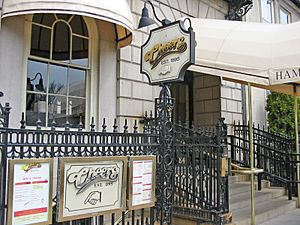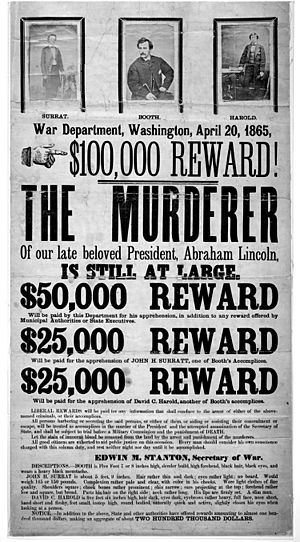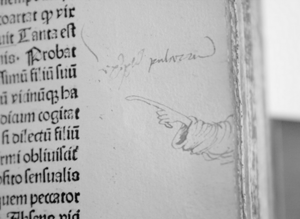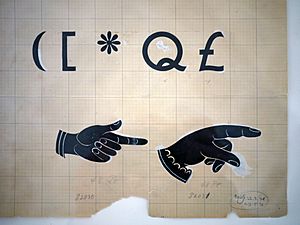Index (typography) facts for kids
Quick facts for kids ☞ |
|
|---|---|
|
Index
|
|
The symbol ☞ is a special punctuation mark. It's often called an index, manicule (which means "little hand" in Latin), or fist. People also call it a printer's fist, pointing hand, or hand director. It looks like a tiny hand with a finger pointing.
Contents
History of the Pointing Hand Symbol

This symbol first appeared a long time ago, in the Middle Ages and Renaissance. Scribes, who copied books by hand, used it in the margins of their manuscripts. They used it to mark corrections or important notes.
Manicules were first seen in the 12th century in handwritten books from Spain. They became very common in Italy during the 14th and 15th centuries. Some were fancy with shading and decorated cuffs. Others were simple, just two quick lines that looked like a pointing hand.
After the printing press became popular around 1450, people still used manicules. They would draw them by hand on printed documents to add notes. Early printers also started using a type that looked like the manicule. For example, Mathias Huss and Johannes Schabeler used it in 1484.
In more recent times, the pointing hand became popular in books, advertisements, and signs that show direction. Some signs even have real, three-dimensional pointing hands. The United States Postal Service has used a pointing hand on its "Return to Sender" stamp.
In modern printing, it was a standard symbol for marking notes. An American dictionary from 1894 listed it as a common footnote marker. It came after the paragraph sign, which is called a pilcrow.
Some experts believe that as these symbols became more standard, they lost their unique touch. This might be why they became less popular over time.
How the Pointing Hand is Used

The main use of the pointing hand is to grab a reader's attention. It's like saying "look here!" or "note this". Both people who add notes to books and printers use it this way.
Even centuries ago, it was used to highlight specific text. This could be a title, an added note, or an important passage. Sometimes, a whole row of manicules would point to something important. Other symbols like flower marks and asterisks were also used for similar reasons.
Less often, in older times, the pointing hand acted as a section divider. A pilcrow would then divide paragraphs. Sometimes, the pointing hand even divided paragraphs itself.
Some encyclopedias use it to link to other articles. You might see it like this: ☞ other articles. Magazines and comic books sometimes use it to show that a story continues on the next page.
In linguistics, which is the study of language, the symbol is used in a theory called "optimality theory". It helps to show the best possible way a word or sound can be made.
The American science fiction writer Kurt Vonnegut used the symbol in his novel Breakfast of Champions. He put it at the start of every paragraph. This made each paragraph stand out on its own. It helped show the "stream of consciousness" style of the book.
The Pointing Hand as a Computer Cursor
A pointing hand that points upwards is often used as a mouse cursor on computers. You can see it in programs like Adobe Acrobat and Photoshop. It shows you an object that you can click on or move.
The Xerox Star computer is thought to be the first to use this type of cursor. Many web browsers use an upward pointing hand cursor. This shows you that something is a clickable hyperlink. CSS 2.0 allows web designers to change the mouse cursor to this symbol. This happens when you move your mouse over certain objects.
Many video games from the 1980s and 1990s also used these cursors. This was especially true for text-based adventure games.
|
See also
 In Spanish: Manecilla (signo) para niños
In Spanish: Manecilla (signo) para niños



